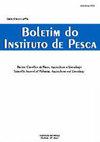Antinutritional effect of lectin from faveira (Parkia platycephala) seeds in tambatinga (Colossoma macropomum x Piaractus brachypomus)
IF 0.6
4区 农林科学
Q4 FISHERIES
引用次数: 0
Abstract
This study investigated the possible antinutritional effects of Parkia platycephala lectin (0, 20, 40, or 60 mg kg-1 of diet) on tambatinga feeding for 60 days as well as methods of inactivating this protein. Weight gain, specific growth rate, and relative weight gain decreased, and the feed conversion rate increased with the increase in dietary lectin. The hepatic glycogen levels of fish fed 60 mg kg-1 were higher than those of fish fed 20 and 40 mg kg-1. Diets containing 40 and 60 mg kg-1 increased muscle glucose levels compared to the control group. Fish-fed diets containing lectin showed reduced muscle glycogen compared to those receiving the control diet. Fish fed 60 mg kg-1 presented lower muscle protein levels than those fed 20 mg kg-1. In vitro tests showed that the hemagglutination activity of lectin was inhibited by d-mannose, d-glucose, and α-methyl-d-mannopyranoside. Thermal treatment at 50–60°C was sufficient to reduce the action of lectin, as well as a pH below and above the 6–7 range. Therefore, the use of P. platycephala meals as a dietary ingredient for tambatinga with no lectin inactivation is not recommended as it can negatively affect the fish’s biochemical parameters and growth. Acid or alkaline solutions can be an alternative for inactivating the protein and improving its use by fish and other animals.蚕豆种子凝集素对柽柳的抗营养作用
本研究探讨了白头Parkia platycephala凝集素(0、20、40或60 mg kg-1日粮)对饲喂60天的丹巴inga可能产生的抗营养作用,以及灭活该蛋白的方法。随着饲粮中凝集素含量的增加,增重、特定生长率和相对增重降低,饲料转化率提高。60 mg kg-1饲料的肝糖原水平高于20和40 mg kg-1饲料。与对照组相比,含有40和60毫克kg-1的饮食增加了肌肉葡萄糖水平。含有凝集素的鱼饲料与对照组饲料相比,肌肉糖原减少。饲喂60 mg kg-1的鱼肌肉蛋白水平低于饲喂20 mg kg-1的鱼。体外实验表明,d-甘露糖、d-葡萄糖和α-甲基-d-甘露糖吡喃苷均能抑制凝集素的血凝活性。50-60°C的热处理足以降低凝集素的作用,以及pH低于或高于6-7的范围。因此,不推荐使用未进行凝集素失活的白头p鱼粉作为tambatinga的饲料成分,因为它会对鱼的生化参数和生长产生负面影响。酸或碱性溶液可以作为灭活蛋白质的替代方法,提高鱼和其他动物对蛋白质的利用。
本文章由计算机程序翻译,如有差异,请以英文原文为准。
求助全文
约1分钟内获得全文
求助全文
来源期刊

Boletim do Instituto de Pesca
FISHERIES-ZOOLOGY
CiteScore
0.80
自引率
0.00%
发文量
24
审稿时长
>12 weeks
期刊介绍:
To publish original articles of research and short communications in the following áreas: Fisheries, Aquaculture, Zootechnology, Limnology, Oceanography, Biology and Pathology of aquatic organisms. The publication depends on the approval of the Editorial Board, based on the peer review.
 求助内容:
求助内容: 应助结果提醒方式:
应助结果提醒方式:


